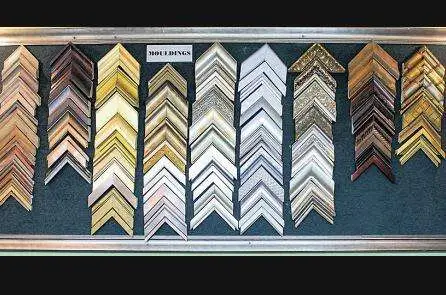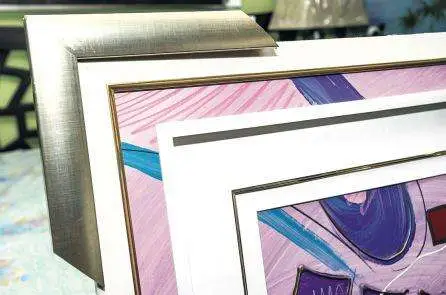
THE ART of framing
Okay, so you’ve just purchased a nice print or painting, or printed some of those wonderful family pictures…now what? Well, Island Art and Framing is your next stop, where their team of expert framers will help you through the process of selecting the perfect frame for you. If you’re in the market for some expert framing work, here are a few things you need to know:
WORKS ON PAPER
Limited-edition prints and original works on paper (regardless of medium) should always be matted and framed under glass or plexiglas (acrylic glazing). They should never be dry-mounted or otherwise permanently adhered to any kind of backing, as this will destroy their value.
The preferred method of mounting these pieces is to hinge them to an acid-free backing board using acid-free linen tape. The tape hinges are at the top only and allow the work to hang freely within the matt and backing. All papers and wood react constantly to the humidity in the air; they need to be able to expand and contract freely. This movement is imperceptible but very important. Any kind of dry-mounting or gluing prevents this, and buckling or wrinkling are the likely results.
PICK A MATT
One of your tasks will be to pick a matt or a matt combination (two or more colours) for the art. Island Art and Framing have a wide selection of these, in many different textures and colours for you to choose from. The mat is a sort of “window” that surrounds the art. It not only complements the piece, but also serves to separate it from the glass or plexiglas. When picking a matt, the number one rule is… forget about matching the sofa or the wall colour! Your goal is to pick a matt and frame combination that complements the art without being a distraction. If you accomplish this, the art will look great no matter where you hang it. If you concentrate on matching your decor, the final framing job won’t complement the art or the room it’s hanging in. It will simply look out of place.
AESTHETICS
Prints are usually matted so that 1- 1 _ inches of white margin shows around the image. It is also usually placed centre in the matt board, but there is no rule book, and depending on what you’re framing, or the look you’re after, this is a mere guideline. The matt board need not be white, nor does it need to be centred. It also does not need any set inches around the image.
PICKING A FRAME MOULDING
After you’ve picked a mat, then you need to choose the moulding that is the actual frame. I can’t offer much advice here because as you can see, there are many options for you to choose from. They range from plain and simple to carved and ornate; they come in finished wood, gold or silver gilt or even bright bold colours, so between you and the team, you will find the perfect frame for your work of art.
HANGING
Plastic wall hooks are the best option because they drive easily into concrete walls. If you’re hanging on drywall, you must find a stud, and drive the hook/nail into the stud; it won’t support the piece if driven into the drywall only. If the piece is especially wide, two hooks will be required. Never hang any artwork in a location where it will receive direct sunlight. Lightfastness of various pigments and materials has improved greatly over the last few decades, but it’s still best to hang all work in indirect light. If you want to “feature” the art on your wall, consider getting one of those small picture lights to mount over the artwork. If you can’t hang artwork on the wall because you’re restricted from driving holes into the walls, then an option is to hang from ceiling moulding or chair-rails instead. Extra-strength double-sided tape is another great option to mount your art or pictures. This is especially useful when your frame does not have wire or hooks from which to hang. This, however, is something of a permanent solution.
The rule of thumb is to hang art at eye level. However, there are times when exceptions can be made; for example, if the art does not require “scrutiny”, then you can hang it high…and fill a blank space in a room with really high walls. Unconventional option can be to prop up against a wall or on a table or shelf. If you choose this option, however, you will need to create some kind of “stop”, so the piece doesn’t slip off or along the surface.
Images by Marc Evans www.marcevansimages.com
























